In this guide, you’ll learn how to visit Mount Hua (Huashan, or Huashan Mountain), including transportation options, things to do, safety tips, and much more. Whether you’re a seasoned hiker or a casual traveler, this complete guide will help you make the most of your visit.
Mount Hua (Huashan Mountain) is one of China’s most iconic mountains and an unforgettable experience for adventurous travelers. Located just 120 kilometers (75 miles) east of Xi’an, Huashan is known for its dramatic peaks, thrilling hiking routes, and rich cultural significance.
1. Basic Knowledge of Mount Hua
Geological and Historical Significance: Mount Hua is part of the Qinling mountain range (秦岭山系) and is known for its unique geological formations and steep cliffs. It has a long history, dating back over 2,000 years, and has been an important site for religious and cultural activities in China.
Five Peaks: Mount Hua is famous for its five peaks, each offering a different experience and view. They are the East Peak (Facing Sun Peak), South Peak (Landing Wild Goose Peak), West Peak (Lotus Flower Peak), North Peak (Cloud Terrace Peak), and Middle Peak (Jade Maiden Peak). The South Peak is the highest ( 2154.90 meters)and most popular among visitors.
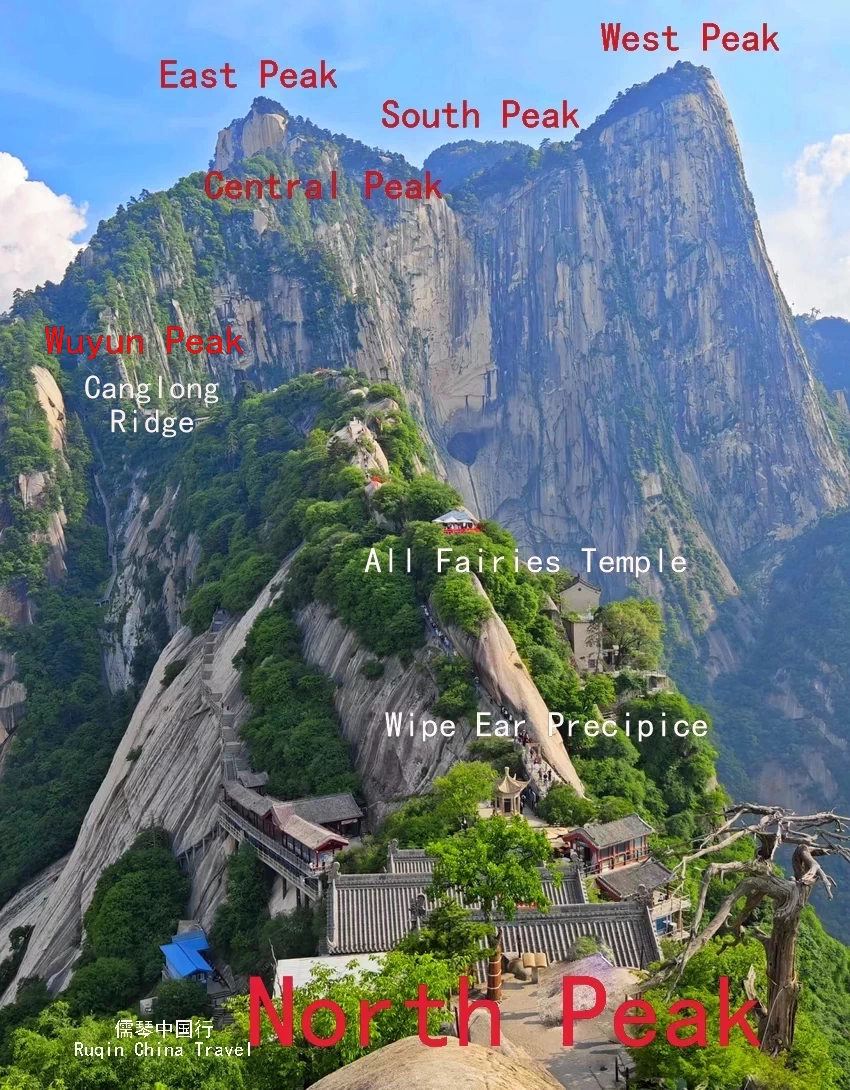
Cultural and Religious Sites: Mount Hua is home to numerous temples and shrines, making it an important place of worship for Taoism and Buddhism. The most famous temple is the Xiyue Temple, located at the foot of the mountain, which dates back to the Tang Dynasty (618 -907). Other notable sites include the Yunyang Palace and the Chess Pavilion.
2. Best Time to Visit Huashan Mountain
Timing is crucial when visiting Mount Hua. The mountain’s weather can greatly affect your experience, and different seasons offer unique highlights.
Spring (March-May)
Spring is one of the best times to visit. The weather is mild, flowers bloom across the mountain, and the trails are less crowded compared to summer.
Summer (June-August)
Summer brings warmer weather but also more tourists. However, the views are stunning, with clear skies and green landscapes.
Be prepared for crowds, especially in late July and August, when school vacations are in full swing. During this time, large crowds of domestic tourists flock to the mountain.
Autumn (September-November)
Autumn is arguably the best season for visiting Mount Hua. The weather is cool and pleasant, and the mountain transforms into a palette of red, orange, and yellow. It’s also less crowded compared to summer.
Winter (December-February)
Winter is the quietest season, but it comes with challenges. The trails can be icy and slippery, requiring extra caution. However, if you enjoy solitude and snowy landscapes, winter offers a magical experience.
Consider the best time to visit Mount Huashan based on weather and peak tourist seasons. Spring (March to May) and autumn (September to November) are generally recommended for pleasant weather and beautiful landscapes. Summers can be extremely hot, and winters are cold.
3. How to Get from Xi’an to Mount Huashan
There are five main ways to travel from Xi’an to Mount Huashan (华山). Here’s a detailed breakdown of the best options, including recommended transportation methods, costs, and useful tips for each.
1) High-Speed Train (高铁/动车) – Recommended 🚄
📍 Route: Xi’an North Railway Station (西安北站) → Huashan North Railway Station (华山北站)
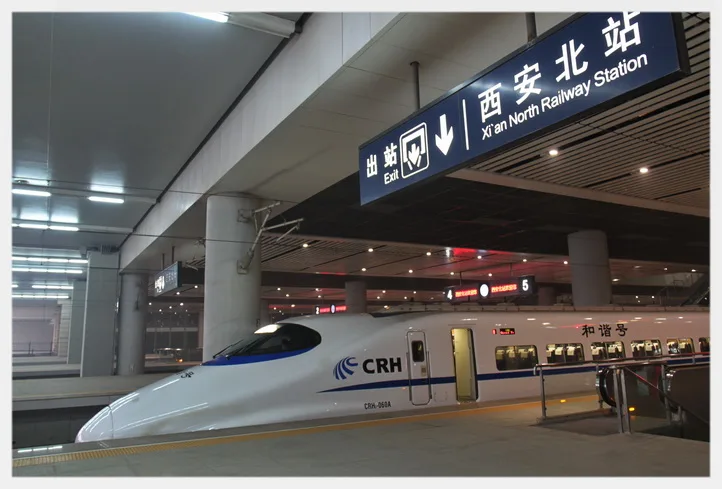
- Schedule: Multiple daily departures, starting around 6:00 AM, with the last train at 9:30 PM.
- Duration: 30-40 minutes.
- Ticket Price:
- High-speed train (高铁): ¥54.5 (Second Class)
- Bullet train (动车): ¥34.5
🔄 Getting to the Scenic Area ( the Tourist Center):
- Free Shuttle Bus: Exit Huashan North Station, turn left to Huayin Bus Station (华阴客运站), and take Bus 1 or 2 (about 15 minutes to the Visitor Center where you purchase entrance tickets ).
- Taxi/Ride-hailing: Around ¥20 to the Visitor Center, and 10 minutes to Yuquan Courtyard (玉泉院), the entrance for hikers.
2) Regular Train (普通火车) 🚂
📍 Route: Xi’an Railway Station (西安火车站) → Huashan Railway Station (华山站)
- Schedule: Multiple daily departures.
- Duration: About 90 minutes.
- Ticket Price: ¥18.5 – ¥30 (Hard Seat).
🔄 Getting to the Scenic Area (the Tourist Center)
- Bus: Take Bus 608 or similar (10-15 minutes).
- Taxi: Around ¥10 to the Visitor Center.
3) Direct Tourist Bus (景区直通车) 🚌
📍 Departure Point: Qinzhifeng Terminal (秦之风发车场), 50m south of Exit C1 of Shijiajie Metro Station (石家街站) (Metro Line 3) in Xi’an
- Schedule: 7:50 AM, 2:00 PM.
- Duration: About 2 hours, direct to the Huashan Visitor Center Parking Lot.
- Ticket Price: ¥60 one-way (no round-trip discount).
🔄 Return Trip:
- Departure Time: 4:00 PM – 6:00 PM, leaves once full from the Huashan Visitor Center.
- Drop-off Points: Bell & Drum Tower (钟鼓楼), Wulukou (五路口), etc in Xi’an
4) Long-Distance Bus (长途大巴) 🚌
📍 From Xi’an Bus Station (西安市汽车站) (opposite the Xi’an railway station)
- Schedule: Runs 6:00 AM – 8:00 PM, buses depart frequently.
- Duration: About 2 hours.
- Ticket Price: ¥40 one-way, ¥70 round-trip.
- Drop-off: Huashan Scenic Area Parking Lot (300m from Visitor Center).
📍 From Xi’an East Bus Station (城东客运站)
- Schedule: 7:00 AM – 7:15 PM, every 15 minutes.
- Ticket Price: ¥26 – ¥30.
5)🗻 Private Day Trip to Mount Hua from Xi’an with English-Speaking Driver
Enjoy a seamless and scenic private day trip from Xi’an to the legendary Mount Hua (Huashan) with your friendly English-speaking driver. After pickup from your downtown Xi’an hotel, you’ll be driven directly to the base of this breathtaking mountain, known for its dramatic peaks and thrilling hiking routes.
Take in the stunning natural scenery, and if weather permits, don’t miss the famous plank walk—a heart-pounding wooden pathway attached to a sheer cliffside. For safety, harnesses are required and provided—a must-do experience for adventure seekers!
Explore the mountain at your own pace, with the flexibility and comfort of private transport. Whether you’re drawn by natural beauty, spiritual history, or adrenaline-filled trails, this day trip makes for an unforgettable journey from Xi’an.
👉 Book your One Day Xi’an Mini Group Tour to Mt. Huashan, No Shopping with local guides via Viator — an unforgettable, immersive experience
6) Driving (自驾) 🚗
📍 Route:
Lianhuo Expressway (连霍高速, G30) → Exit at Huayin (华阴出口) → Yingbin Avenue (迎宾大道) → Huashan Scenic Area (5-minute drive).
- Duration: 1.5 – 2 hours.
- Toll Fee: About ¥60.
- Parking Fee: ¥20 per day (overnight parking +¥10).
7) Additional Tips 📌
🚌 Huashan Scenic Area Transportation
Once at the Visitor Center, you can take a shuttle bus to the cable car stations:
- North Peak Cable Car (北峰索道): ¥20, 10-minute ride.
- West Peak Cable Car (西峰索道): ¥40, 40-minute ride.
🎟 Cable Car Ticket Prices:
- North Peak: ¥80 (one-way).
- West Peak: ¥140 (one-way).
🚆 Returning to Xi’an
- Last high-speed train from Huashan North: Around 9:30 PM. Arrive at the station at least 1 hour early.
- Missed the last train? Share a carpool ride to Xi’an for around ¥150 per car.
This transpoertation guide covers everything you need to know to travel smoothly from Xi’an to Mount Huashan.
4. Accommodation on Mount Huashan (华山)
If you’re planning an overnight stay on or near Mount Huashan, here’s a breakdown of the best options, from mountaintop hotels with stunning sunrise views to convenient lodgings at the base.
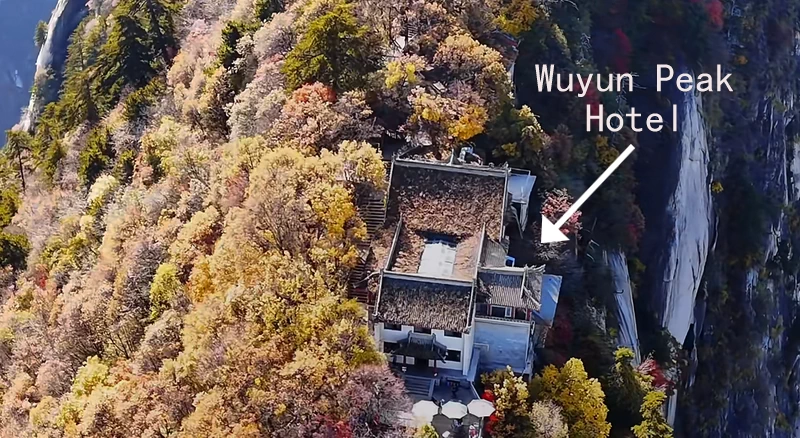
1) Staying on Huashan Mountain
For those looking to experience the mountain at sunrise or sunset, staying overnight on the mountain is a great option. Here are the top hotels categorized by peak:
East Peak (东峰) – Best for Sunrise Views
- Hotel: Huashan East Peak Hotel (华山东峰饭店)
- Location: At the summit of East Peak, near Chaoyang Platform (the best sunrise viewpoint)
- Address: South side of East Peak, next to the “Sparrow Hawk Flips Over” (鹞子翻身) scenic spot
- Contact: 0913-4301312
- Highlights:
- The only hotel at the top of East Peak, just a 2-minute walk from the sunrise viewing platform.
- Offers dormitory beds (from ¥180 per person) and standard rooms (from ¥1100 per night).
- Close to the thrilling “Sparrow Hawk Flips Over” climbing challenge.
West Peak (西峰) – Best for Sunset & Stargazing
- Hotel: Huashan West Peak Hotel (华山西峰饭店), also known as Cuiyun Palace (翠云宫)
- Location: On the mountainside of West Peak, near the West Peak Cableway exit
- Address: Midway up West Peak, beside the “Axe-Split Rock” (斧劈石)
- Contact: 0913-4300078
- Highlights:
- Best sunset viewpoint on Huashan, just a 10-minute walk from the cableway station.
- Offers dormitory beds (from ¥150 per person) and standard rooms (from ¥1100 per night).
- Features traditional wooden architecture and excellent night views of the starry sky.
North Peak (北峰) – Best for Panoramic Views
- Hotel: Yuntai Mountain Villa (云台山庄, formerly Beifeng Hotel)
- Location: Summit of North Peak, where the cableway and hiking routes meet
- Address: Yuntai Peak, at the end of the famous Huashan Plank Road
- Contact: 0913-4300066
- Highlights:
- Best panoramic viewpoint on Huashan, ideal for photography.
- Offers budget dormitory beds (from ¥78 per person) and standard rooms (from ¥490 per night).
- Close to scenic spots like Ear-Rubbing Cliff (擦耳崖), Fish Rock (鱼石), and Memorial Pavilion (纪念亭).
Wuyun Peak (五云峰) – Best for Both Sunrise & Sunset
- Hotel: Wuyun Peak Hotel (五云峰饭店)
- Location: Between Golden Lock Pass (金锁关) and Canglong Ridge (苍龙岭), a main route through the mountain
- Address: Summit of Wuyun Peak, near Canglong Ridge
- Contact: 0913-4300019, 0913-3020337
- Highlights:
- Good facilities compared to other mountaintop hotels.
- Offers dormitory beds (from ¥150 per person) and standard rooms (from ¥980 per night).
- Spacious dining area, perfect for resting during a long hike.
South Peak (南峰) – No Accommodation
- There are no hotels on South Peak. Travelers wanting to stay overnight nearby should choose East Peak or West Peak instead.
2) Staying at the Base of Huashan Mountain
If you prefer comfort or are planning a night hike, staying near the mountain entrance is a smart choice. Here are some recommended hotels:
Near the Huashan Scenic Area Entrance
- Huashan Inn (华山客栈) – Wuxia (martial arts) Themed Hotel
- Location: 8 Yiquan Road, next to the Huashan hiking trail entrance
- Contact: 0913-4368888
- Highlights:
- Martial arts-themed décor inspired by Chinese kung fu legends.
- Just a 5-minute walk from the Yuqian Temple (玉泉院), a common starting point for night climbers.
- Huamei Elegant Hotel (华美雅致酒店) – Best Value for Money
- Location: North side of the Baolian Lantern Roundabout, near the Visitor Center
- Contact: 0913-4330000
- Highlights:
- Affordable rates with free shuttle service to the scenic area.
- Great for those looking for a budget-friendly yet comfortable stay.
In Huayin City (华阴市区) – More Comfortable Options
- Huashan International Hotel (华山国际大酒店) – Best for Business & Families
- Location: Mid-section of Jiling Road, 10 minutes by car from the scenic area
- Contact: 0913-4333333
- Highlights:
- 4-star hotel with modern amenities, perfect for business travelers or families.
- Spacious rooms, well-equipped facilities, and an overall comfortable stay.
3) Practical Travel Tips
Booking Mountaintop Accommodation
- Peak season (April–October): Book 1–2 weeks in advance to secure a spot.
- Dormitory beds do not have private bathrooms—bring your own toiletries.
Choosing the Right Hotel at the Base
- For night hikers: Stay near Yuquan Temple, which is the best starting point.
- For drivers: Choose hotels that offer parking.
Price Guide
| Type | On the Mountain | At the Base |
|---|---|---|
| Dormitory Bed | ¥78 – ¥210 per person | ¥150 – ¥300 per night |
| Standard Room | ¥490 – ¥1100 per night | ¥300 – ¥800 per night |
(Prices may vary during holidays—contact hotels directly to confirm rates.)
With this guide, you can find the perfect place to stay based on your budget and travel style. Whether you want to wake up to a sunrise over the peaks or relax in comfort before your climb, Huashan has accommodation options for everyone!
5. Huashan Entrance Fees and Tickets
Before starting your adventure at Mount Hua, you’ll need to stop at the Huashan Visitor Center, located at the northern base of the mountain. This is where you can purchase all necessary tickets for your visit, including entrance fees, shuttle bus tickets, and cable car passes.
Kind Reminder:
Generally, foreign travelers can use credit cards (Visa or MasterCard) at the Tourist Service Center to pay for entrance tickets, cable car rides, and shuttle buses. However, there have been occasional issues—sometimes due to travelers’ own banks—that prevent successful card transactions.
To avoid any inconvenience, I recommend notifying your bank ahead of your trip to China, so your card won’t be mistakenly blocked during the transaction.
Also, the staff advised that it’s a good idea to carry a small amount of cash while hiking on the mountain, just in case you need it along the way.
Huashan Mountain Hotline: 0913 8375999
Official Website: chinahuashan.com
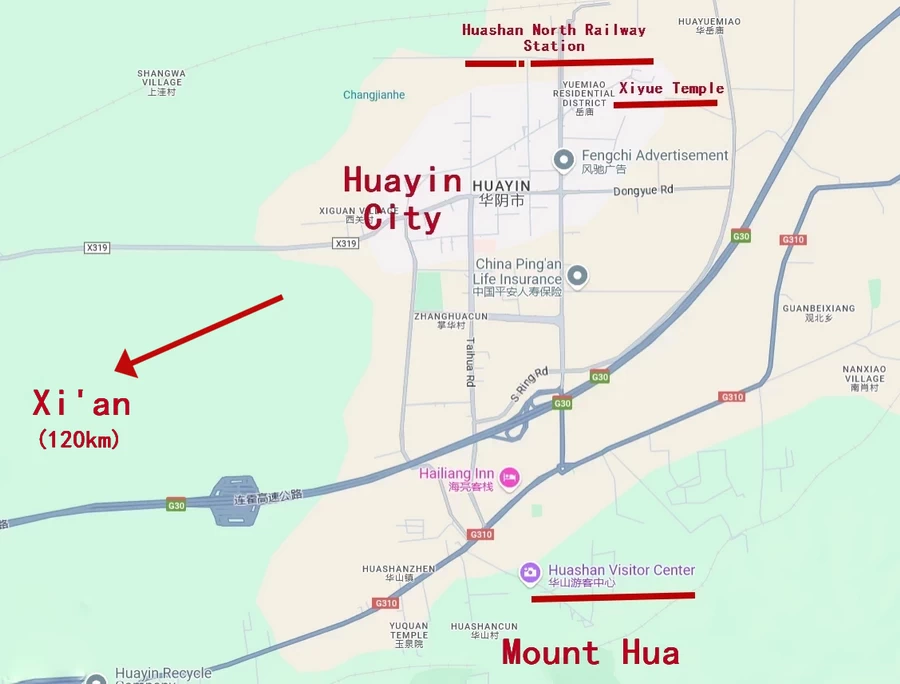
At the Huashan Visitor Center, you can buy the following tickets:
Entrance Tickets: Required for access to the scenic area, priced around 160 CNY (varies slightly by season). The entrance tickets are valid with 48 hours.
Shuttle Bus Tickets: To reach the cable car stations, you’ll need to take a shuttle bus, which costs about 40 CNY for a round trip.
Cable Car Tickets: Whether you’re heading to the North Peak or West Peak, cable car tickets can be purchased here. The North Peak cable car is 80 CNY one-way, while the West Peak cable car costs 140 CNY one-way.
Additionally, if you’re arriving by high-speed train from Xi’an, shuttle buses are available at Huashan North Railway Station to take you directly to the Huashan Visitor Center. This makes it easy for visitors to seamlessly transition from the train station to the start of their Huashan adventure.
By organizing everything at the Huashan Visitor Center, you can ensure a smooth and efficient start to your day at Mount Hua.
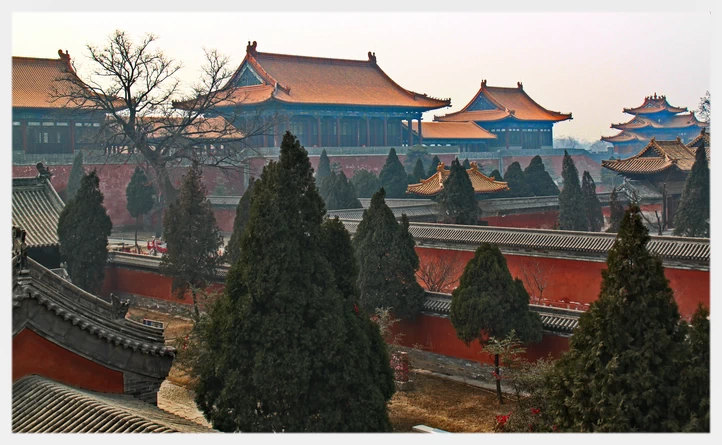
Note: The entrance ticket also allows you to visit other three attractions: Xiyue Temple, Yuquan Temple and Xianyu Valley. Xiyue Temple, in particular, is worth visiting!
6. Cable Car or Hiking
Decide whether you want to take the cable car up the mountain or hike. Hiking is challenging but provides a more immersive experience. The cable car is a convenient option, especially if you’re short on time or not comfortable with steep trails.
There are two cable car stations – one at the North Peak and the other at the West Peak. You may take the cable up to the north peak, then hike to the West Peak and take the West Peak’s cable car down – This North Peak up and West Peak down is very much challenging! Instead, West Peak Up and North Peak down is comparatively easier.
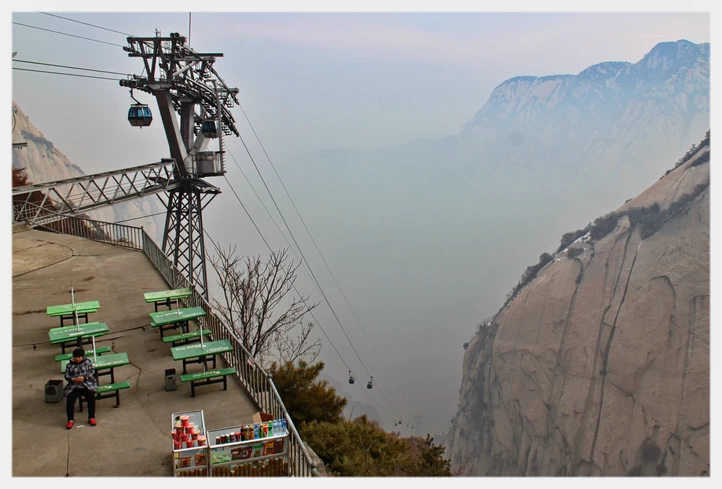
You don’t have to retrace to the North Peak. Of course, you need strong legs hiking from the north peak to the west peak. If you don’t have strong legs, you may retrace to the north peak, take cable car down.
Note: The last cable car starts at 19:00 ( high season: March – November ); 17:00 ( low season: December – February ).
Cable car ticket: RMB 80 (two ways Dec – Feb); RMB150 (two ways March – November). The cable car ticket is separated from the entrance tickets and people have to buy at the cable car station. Each cable car accommodates 6 passengers.
North Peak Cable Car: This is the more popular and shorter route, taking you directly to the North Peak in just 8-10 minutes. It’s ideal for beginners or those with less time.
West Peak Cable Car: The West Peak cable car is longer and more scenic, offering stunning views as you ascend the cliffs. This route is often preferred by travelers who want to hike to the north peak in an easy way – Most of the hike is downhill or on level ground.
7. Mount Huashan Hiking Guide
Mount Huashan (华山) offers breathtaking scenery and thrilling hikes. To help you choose the best route, here’s a breakdown of the most efficient and alternative hiking routes, along with key tips to make your journey smoother.
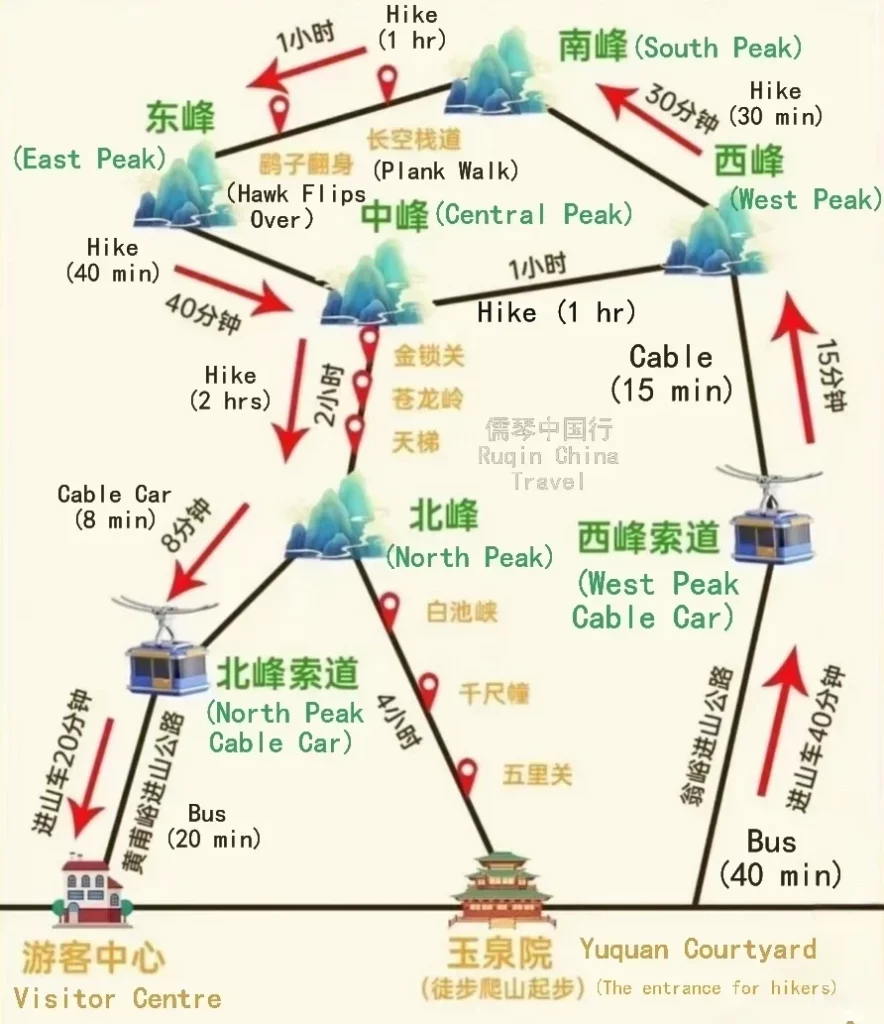
1) Recommended Easiest Route: West Peak Up → North Peak Down (西上北下)
This route is the best way to save energy while still seeing all the major sights.
Route Plan
- Ascent: Take the tourist shuttle (40 min) from the Visitor Center to the West Peak Cableway station, then ride the cable car (20 min) up to the West Peak (2086m).
- Hiking Route:
- West Peak (西峰) – See Axe-Split Rock (斧劈石) and Chenxiang Rescues His Mother Pavilion (沉香救母亭).
- South Peak (南峰) – The highest point of Huashan (2154m) and home to the thrilling Plank Walk (长空栈道).
- East Peak (东峰) – Experience the Sparrow Hawk Flips Over (鹞子翻身) climb and the best sunrise viewpoint.
- Middle Peak (中峰) – Visit the Fairy Maiden Temple (玉女祠).
- North Peak (北峰) – Walk along the famous Canglong Ridge (苍龙岭) and see the Huashan Sword Debate Monument (华山论剑碑).
- Descent: Take the North Peak Cableway (8 min), then the tourist shuttle (20 min) back to the Visitor Center.
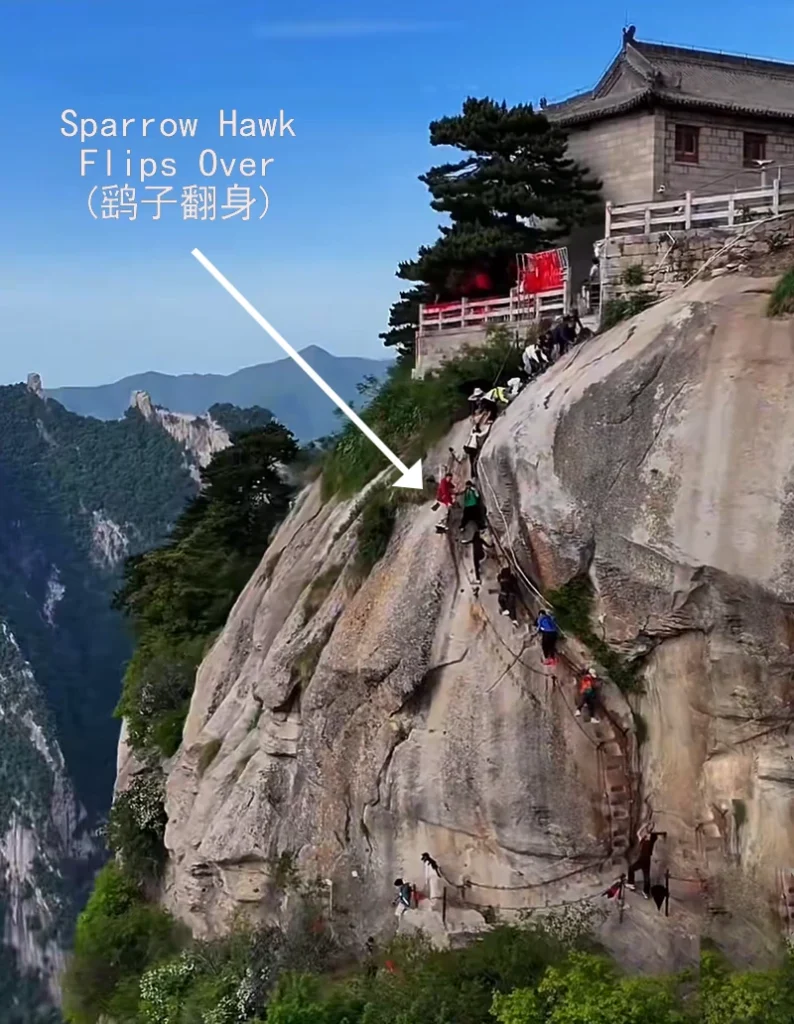
Total Time Needed
🕒 5–7 hours total (including cableways)
🚶♂️ 4–5 hours of hiking
Why Choose This Route?
✅ Saves Energy – Most of the hike is downhill or on level ground.
✅ Covers All Major Attractions – You’ll visit all five main peaks and both major adventure spots (Plank Walk & Sparrow Hawk Flips Over).
✅ Avoids Crowds – The counterclockwise route reduces congestion from tour groups.
Cost Breakdown
💰 Total: ¥440 per person
- Entrance Ticket: ¥160
- West Peak Shuttle Bus: ¥40
- West Peak Cableway: ¥140
- North Peak Cableway: ¥80
- North Peak Shuttle Bus: ¥20
🔔Kind Remider:
If you want to avoid the Plank Walk and Hawk Flips Over sections due to the fear-inducing features, you don’t need to worry—while the Plank Walk and the Hawk Flips Over are some of Huashan’s most famous (and fear-inducing!) features, they are completely optional and not required for the route you’re planning. These are both side attractions that branch off the main trail and require a separate ticket (30 RMB per person per activity). You can easily skip them and still enjoy a full and beautiful hike.
2) Alternative Routes – Which One is Right for You?
| Route | Best For | Pros & Cons | Cost (Including Entry Ticket) |
|---|---|---|---|
| North Up → West Down (北上西下) Cable up and down Hiking the five peaks | Adventurous hikers, photographers | ✅ Scenic Canglong Ridge hike 🌄 ❌ Steep uphill climbs, takes ~9 hours | ¥340–440 |
| West Up → West Down (西上西下) Cable Up and down Hike the four peaks (No North Peak) | Families, elderly, short on time | ✅ Easiest route, least walking ❌ Misses North Peak and some attractions, most expensive | ¥520 |
| North Up → North Down (北上北下). Cable up and down. Do some hiking only at the North Peak for sightseeing | Tourists who may not have strong legs but still want to enjoy the spectacular views of Mount Hua can do so without strenuous hiking. | At the North Peak, you can take in the most breathtaking panoramic views of the surrounding peaks in Huashan. | ¥360 |
3) Essential Tips for Your Huashan Adventure
Thrill-Seeker Spots
- Plank Walk (长空栈道) – South Peak: A narrow wooden path hanging off a cliff. Safety harness rental required (¥30–50). Go early in the morning to avoid long wait times.
- Sparrow Hawk Flips Over (鹞子翻身) – East Peak: A nearly vertical climb using iron chains. Not for the faint-hearted!
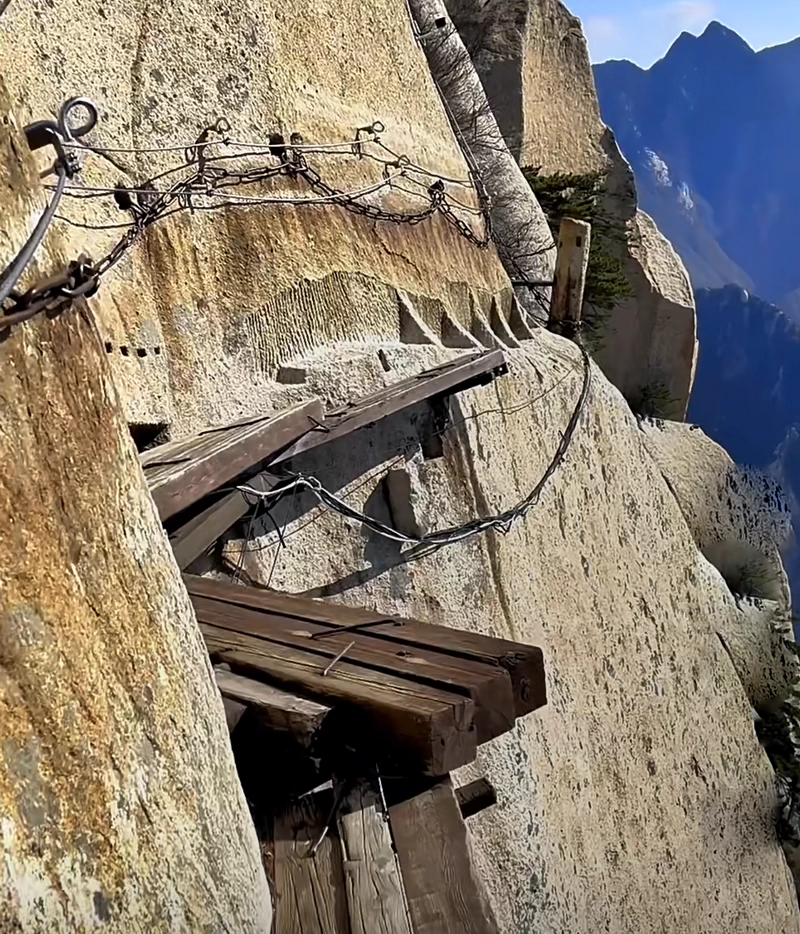
Cableway Schedule
- West Peak Cableway: Last ride at 6:00 PM
- North Peak Cableway: Last ride at 7:00 PM
⏳ Make sure to leave at least 1 hour before closing time to reach the stations.
Packing List
✅ Non-slip hiking shoes – The trails can be steep.
✅ Gloves – Helpful for gripping chains on steeper sections.
✅ Windproof jacket – The temperature is 8–10°C colder at the summit.
✅ Headlamp/flashlight – Essential for night hikes.
Avoiding Crowds
- Weekends and holidays can be very busy, with cableway wait times over 1 hour.
- Arrive before 7:00 AM to get ahead of the crowds.
With this guide, you can pick the perfect route for your fitness level and experience an unforgettable adventure at Mount Huashan!
8. Sunrise and Sunset Views
Watching the sunrise or sunset from one of the peaks of Mount Hua is a highly recommended experience. The breathtaking views and the changing colors of the sky make it an unforgettable sight.
Huashan Sunrise and Sunset Time in a year
| Months | Sunrise | Sunset |
| Jan-Feb | 7:42-7:47 | 17:45-18:03 |
| Mar-Apr | 6:35-7:10 | 18:35-18:56 |
| May-June | 5:29-5:44 | 19:08-19:28 |
| July-Aug | 5:31-5:44 | 19:44-19:57 |
| Sept-Oct | 6:15-6:29 | 18:04-19:10 |
| Nov-Dec | 6:03-6:24 | 17:35-18:47 |
9. Mount Hua Safety Tips
Safety should always be a top priority when visiting Mount Hua. Here are a few tips to keep in mind:
Watch the Weather: Check the weather forecast before your hike. Avoid hiking in heavy rain or snow, as the trails can become slippery.
Stay on Marked Trails: Avoid taking shortcuts or wandering off the marked paths, as some areas are dangerous.
Use Safety Gear: If you’re doing the Plank Walk or other challenging routes, always use the provided safety gear.
Mount Huashan can be physically demanding and has some challenging sections. It is important to be prepared and take necessary safety precautions. Be cautious while hiking, follow the designated paths, and avoid risky behaviors. If you have any medical conditions or physical limitations, consult with a healthcare professional before attempting the hike.
10. Guided Tours to Mount Hua
If you prefer a more structured experience, consider booking a guided tour (just book a private transfer). Many companies in Xi’an offer day trips or multi-day tours to Mount Hua, including transportation, entrance fees, and a guide to help you navigate the trails.
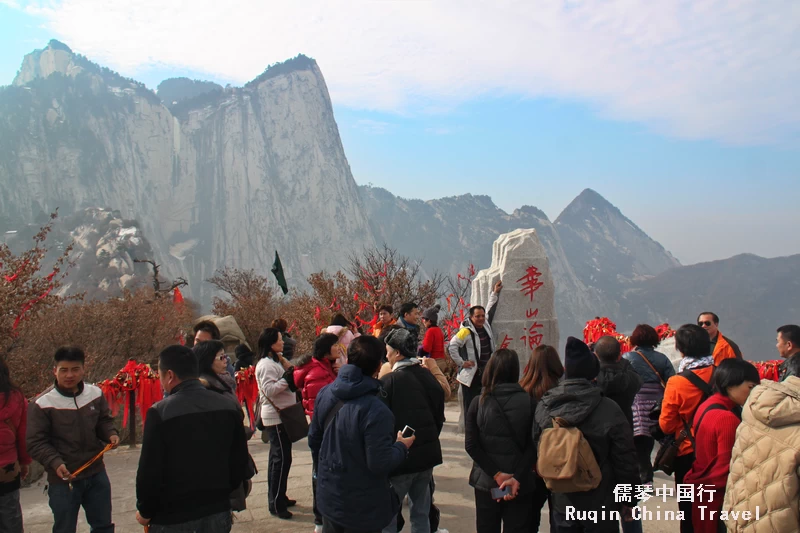
1) Recommende Tour Operators in Xi’an
Ruqin China Travel is not a travel agency, but we specialize in offering expert travel advice to help make your trip as smooth and enjoyable as possible. If you’re looking for a reliable tour operator in Xi’an, we recommend using the Viator platform, where you’ll find trusted local travel agencies.
2) International Youth Hostels in Huashan (With Private Tour Arrangements for Foreign Travelers)
If you’re a foreign traveler looking for budget-friendly accommodation near Mount Huashan, these international youth hostels are great options. They offer comfortable stays, travel assistance, and private tour arrangements to help you explore Huashan hassle-free.
A. Huashan International Youth Hostel (华山国际青年旅舍)
📍 Location: Huayin City, Huashan Road (Near the Yuquan Temple hiking entrance)
📞 Phone: 0913-4363688
Why Stay Here?
✅ Perfect for Hikers – Located just minutes from the Yuquan Temple trailhead, making it ideal for those planning a night hike or an early start.
✅ Travel Assistance – The hostel helps book entrance tickets, group tours, and transportation to and from Huashan.
✅ Social & Cozy Atmosphere – A great place to meet fellow travelers and exchange hiking tips over a cup of tea in the common area.
🚶♂️ Best For: Budget travelers, solo adventurers, and those who prefer hiking up instead of taking the cable car.
B. Huashan Baolianju International Youth Hostel (华山宝莲居国际青年旅舍)
📍 Location: Intersection of Huashan Road & Kangfu Road (50 meters northeast of Huashan Inn)
华阴市华山路与康复路交叉口(华山客栈东北侧50米)
📞 Phone: 0913-4365678
Why Stay Here?
✅ Multilingual Travel Support – Staff speak English, and some can assist in Japanese and Korean, making it easier for international travelers.
✅ Hiking Gear Rentals – Need gloves, flashlights, or trekking poles? The hostel offers affordable gear rentals so you don’t have to buy new equipment.
✅ Convenient Location – A short walk from restaurants, convenience stores, and the Huashan scenic area entrance.
🚶♂️ Best For: Foreign tourists who need language support, those renting hiking gear, and budget travelers looking for a social atmosphere.
Additional Perks for Foreign Travelers 🌍
- Both hostels have English-speaking staff, and some provide Japanese and Korean language support.
- They can arrange private guided tours for international visitors, ensuring a smoother and more enjoyable experience.
💡 Pro Tip: Staying at a youth hostel is a great way to connect with fellow travelers, get local insights, and arrange guided hikes without breaking the bank.
Whether you’re hiking solo or with friends, these hostels provide a comfortable, budget-friendly base for your Huashan adventure! 🏔️
11. Huashan Food & Restaurant Guide
A day of hiking on Mount Huashan can be physically demanding, so knowing where to grab a meal is essential. Here’s a guide to the best dining options both on the mountain and at the base, from quick snacks to hearty Shaanxi specialties.
1) Restaurants on the Mountain (Inside the Scenic Area)
Food options at the top of Huashan are limited and more expensive, but they provide much-needed energy for hikers.
📍 Dongfeng Hotel Restaurant (东峰饭店餐厅) – Highest-altitude Dining Spot
- Location: East Peak summit, near the Sparrow Hawk Flips Over (鹞子翻身) climbing area
- Phone: 0913-4301312
- Must-Try Dishes:
- Stir-fried Huashan Wild Vegetables with Eggs (华山野菜炒蛋) – A fresh and light dish using local wild greens.
- Shaanxi Minced Meat Noodles (臊子面) – A flavorful, slightly spicy noodle soup.
- Hot Ginger Tea (热姜茶) – A perfect way to warm up in the cold mountain air.
- Price Range: ¥50-80 per person
- Why Eat Here?
✅ Best spot for a sunrise meal – Refuel after an early morning hike.
✅ Simple hot meals and drinks – Ideal for warming up before tackling more trails.
📍 Wuyun Peak Hotel Restaurant (五云峰饭店餐厅) – Largest Dining Spot in the Scenic Area
- Location: Wuyun Peak summit, between Canglong Ridge (苍龙岭) and Golden Lock Pass (金锁关)
- Phone: 0913-4300019
- Must-Try Dishes:
- Lamb Paomo (羊肉泡馍) – A famous Shaanxi dish with torn flatbread soaked in rich lamb soup.
- Sour Soup Dumplings (酸汤水饺) – Handmade dumplings served in a tangy broth.
- Liangpi (凉皮) – A cold, chewy noodle dish, perfect for a quick energy boost.
- Price Range: ¥60-100 per person
- Why Eat Here?
✅ The largest restaurant in the main peak area – More seating, faster service.
✅ Authentic Shaanxi cuisine – Great for a hearty meal during or after your hike.
📍 West Peak Cableway Snack Stand (西峰索道站简餐区) – Quick & Convenient
- Location: At the exit of the West Peak cableway station
- Phone: No fixed line (managed by the scenic area)
- Must-Try Snacks:
- Roujiamo (肉夹馍) – The “Chinese hamburger” with slow-cooked meat in a crispy bun.
- Steamed Corn (玉米) – A simple, healthy snack for energy.
- Instant Meal Boxes (速食盒饭) – Quick, no-fuss meals for hikers in a hurry.
- Price Range: ¥20-40 per person
- Why Eat Here?
✅ Fast food-style service – Perfect for those short on time.
✅ Supports mobile payments – Just scan and go!
2) Restaurants at the Base of Mount Huashan (Near the Entrance & Huayin City)
If you prefer better food at lower prices, grab a meal before or after your hike in Huayin City.
📍 Huashan Inn Jianghu Restaurant (华山客栈·江湖菜馆) – A Kung Fu-Themed Dining Experience
- Location: 8 Yuquan Road, inside Huashan Inn, near the hiking entrance
- Phone: 0913-4368888
- Must-Try Dishes:
- Huashan Spring Water Fish (华山泉水鱼) – Fresh fish steamed with local mountain spring water.
- Dadao Noodles (大刀面) – Handmade wide-cut noodles with a chewy texture.
- Hulu Chicken (葫芦鸡) – A crispy-skinned roasted chicken, a Shaanxi specialty.
- Price Range: ¥80-120 per person
- Why Eat Here?
✅ Martial arts-inspired décor – Feels like stepping into a classic Kung Fu movie!
✅ Fusion of Shaanxi flavors and creative dishes – Unique twists on local favorites.
📍 Laotongguan Roujiamo (老潼关肉夹馍) – Best Quick Bite Before Hiking
- Location: East side of the commercial street near the Huashan Visitor Center
- Phone: 0913-4362111
- Must-Try Dishes:
- Tongguan Roujiamo (潼关肉夹馍) – Juicy shredded meat in a crispy bun.
- Liangpi (凉皮) – Refreshing and slightly spicy cold noodles.
- Bingfeng Soda (冰峰汽水) – A local orange soda, perfect with Shaanxi street food.
- Price Range: ¥15-30 per person
- Why Eat Here?
✅ Fast service – Ideal for grabbing a quick meal before starting your hike.
✅ Classic Shaanxi street food – Cheap, delicious, and satisfying.
📍 Mengji Lamb Paomo (华阴市孟记羊肉泡馍) – Local Favorite for Hearty Soups
- Location: Mid-section of Taihua South Road, near Huashan North Railway Station
- Phone: 0913-4335555
- Must-Try Dishes:
- Lamb Paomo (羊肉泡馍) – Thick, flavorful lamb soup with torn flatbread.
- Water Basin Lamb (水盆羊肉) – A lighter, soupy version of lamb paomo.
- Sweet Pickled Garlic (糖蒜) – A tangy side dish that balances the richness of the soup.
- Price Range: ¥25-40 per person
- Why Eat Here?
✅ Loved by locals – One of the most famous spots for lamb paomo in Huayin.
✅ Take-home option – Offers vacuum-sealed packages so you can enjoy it later.
3) Useful Food Tips for Your Huashan Trip
🍱 Eating on the Mountain
- Expect higher prices due to the difficulty of transporting food up the mountain.
- Bottled water: ¥10 per bottle
- Instant noodles: ¥15 per cup
- Bring some snacks (nuts, protein bars) for quick energy boosts.
- Some mountaintop restaurants only accept cash, so carry small bills.
🥣 Best Meal Times at the Base
- Breakfast:Visitor Center food stalls (5:30–8:00 AM)
- Recommended: Youcha & Mahua (油茶麻花), Vegetable-Stuffed Flatbread (菜夹馍)
- Late Night Snacks:Huashan Night Market (8:00 PM–12:00 AM)
- Recommended: Grilled Lamb Skewers (烤羊肉串), Steamed Sticky Rice Cake (甑糕)
🎁 Local Food Souvenirs
- Huashan Pine Nuts (华山松子) – Available at the Visitor Center gift shop (¥50 per jin).
- Dadao Noodle Gift Box (大刀面礼盒) – Vacuum-sealed packs sold at Huashan Inn Jianghu Restaurant (¥30 per pack).
With this guide, you’ll know exactly where to eat and what to try for an authentic Huashan experience! Whether you need a quick snack or a full meal, you’ll find great options on and off the mountain.
👉 Book your One Day Xi’an Mini Group Tour to Mt. Huashan, No Shopping with local guides via Viator — an unforgettable, immersive experience
Visiting Mount Hua is an unforgettable experience, whether you’re drawn by its rich history, breathtaking views, or thrilling hiking routes. By following this complete guide, you’ll know exactly how to visit Mount Hua (Huashan) and make the most of your adventure. Remember to plan ahead, pack appropriately, and stay safe as you explore one of China’s most famous mountains!
If you have any questions or queries, then please feel free to drop us a line.
More Xi’an Travel Guides
Planning your Xi’an Tour? Our ” Xi’an Travel Guide” section offers essential advice to help you navigate the city like a pro. From transportation tips and local customs to insider recommendations for hidden gems, these travel tips will ensure you have a smooth, enjoyable, and unforgettable experience in China’s vibrant capital. Let us guide you through the best practices for exploring Xi’an with confidence!

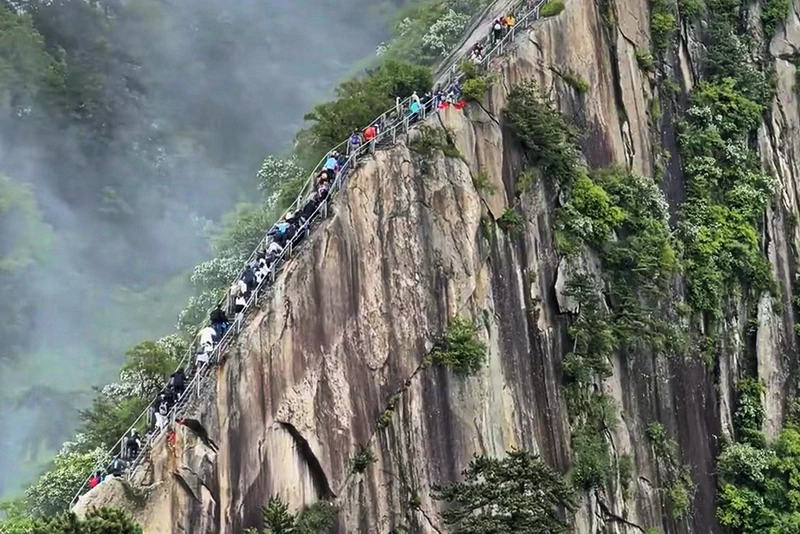
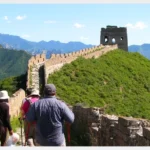
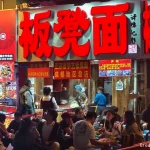
Please provide quotation for family of 5 adults to Mt. Huashan on 7 Oct 2024.
– Pick up/drop off at Somerset Aparthotel Xindicheng Xi’An
– Entrance Tickets
– Shuttle Bus tickets to Cable Car Station
– Cable Car Tickets up/down
Hello Jeffery,
Thanks for your inquiry about your day trip to Mt. Mount Huashan!
We’ll contact you by email for the quotations. Thanks! Daniel from Ruqin China Travel
Hi!
I am considering doing The North Peak Route (Beginner-Friendly), walking up to the north peak and coming down by cable car. How well is the path signed? Is there any exposed section? Would you consider it feasible for a solo hiker?
Thanks! 🙂
Hi Marta,
Thanks for reaching out to Ruqin China Travel!
The North Peak route of Mount Hua is indeed a good choice for beginners. Regarding your questions:
Path Signage: The signage along the North Peak route is relatively clear, with many direction signs along the way, so you generally won’t get lost. However, it’s recommended to download a map or take a photo of the route markers before setting off, just in case.
Exposed Sections: Overall, the North Peak route is quite safe, without particularly dangerous exposed sections. However, since Mount Hua is steep in certain areas, you may encounter some sections that require climbing up steep slopes, so it’s advised to proceed cautiously.
Is It Feasible for Solo Hikers?: For those with good physical fitness and basic hiking experience, solo hiking is feasible. However, it’s recommended to inform family or friends of your itinerary beforehand and to be mindful of safety along the way.
Hiking Time: Hiking from the foot of the mountain to the North Peak generally takes 4-6 hours, depending on your pace and stamina. You can take several breaks along the way to enjoy the scenery.
By the way, The starting point for climbing Mount Hua’s North Peak is Yuqian Temple (玉泉院). Located at the foot of the West Peak, Yuqian Temple is the traditional starting point for the hike. Starting from here allows visitors to experience the ancient and mysterious charm of Mount Hua.
From Yuqian Temple, visitors will pass through several scenic spots, including Wuli Pass, Shaluo Ping, Maonü Cave, Qingke Ping, Huixin Stone, Thousand-Foot Precipice, Hundred-Foot Gorge, and Laojun Plough Groove, before finally reaching the North Peak. The North Peak has an elevation of 1,614 meters and is named for its northern location. Surrounded by steep cliffs, the peak is crowned with cloud-like views and stands majestically, earning the nickname “Yuntai Peak” (Cloud Platform Peak).
Historically, the North Peak was the main route for ascending Mount Hua. From the North Peak, visitors can continue through Cair Cliff, Canglong Ridge, Wuyun Peak, and Jinsuo Pass. After reaching Jinsuo Pass, they can explore the Central Peak and then visit the East, West, and South Peaks on a circular route.
I hope this information helps you better plan your hiking trip!
Ruqin China Travel
Daniel Li
Good day, I plan a visit to huashan on 13 Dec 2024. Is the cable car operating for both peak during this time?
How much is the private transfer from downtown Xian to huashan (2 ways) for 3 pax?
Many thanks
Hello Jojo,
Thanks for reaching out to Ruqin China Travel!
Yes, the cable cars at Mount Hua are open in December. According to the announcement from the Mount Hua Scenic Area Management Committee, the cable car operating hours are from 7:00 a.m. to 7:00 p.m. daily, though specific hours may be adjusted based on actual conditions.
Cable Car Operating Hours
Peak Season (March 1 to November 30): Daily from 7:00 a.m. to 7:00 p.m.
Off-Season (December 1 to the end of February): Daily from 8:00 a.m. to 6:00 p.m.
Cable Car Types and Ticket Prices
Mount Hua Scenic Area has two main cable cars:
West Peak Cable Car: Peak season ticket price is 150 RMB per person; off-season price is 120 RMB per person.
North Peak Cable Car: Peak season ticket price is 150 RMB per person; off-season price is 120 RMB per person.
Please note that Ruqin China Travel is an advisory website offering travel information and recommendations, but we are not a travel agency and do not provide booking services.
For traveling from downtown Xi’an to Mount Hua, we highly recommend taking the high-speed train from Xi’an North Railway Station to Huashan North Railway Station. Once you arrive, you can either take a shuttle bus (though it may not be available in December) or a taxi for around 10 yuan. This will take you to the Tourist Center, where you can purchase your entrance tickets and arrange for cable car service. The process is straightforward and easy to manage.
Please feel free to reach out if you have any further questions!
Best Regards,
Daniel
Ruqin China Travel
Hello Jojo,
Just a follow-up to my previous email reply. For high-speed train ticket booking, please check out How to Buy Train Tickets in China online as a Foreigner for more information.
Have a good trip to Mount Hua!
Daniel
Ruqin China Travel
Please provide quotation for 2 adults to Mt. Huashan on 20th March 2025
– Pick up/drop off at Xi’An hotel.
– Entrance Tickets
– return Shuttle Bus tickets to Cable Car Station
– Cable Car Tickets up/down from west peak.
Hi Rose,
Thanks for reaching out! Your plan to visit Mt. Huashan sounds fantastic—it’s one of the most breathtaking mountains in China!
Just to clarify, we’re not a travel agency, but we specialize in providing travel advice to help make your trip as smooth as possible. However, we can recommend two reputable travel agencies in Xi’an:
Travelchinaguide (www.travelchinaguide.com)
China Xian Tour (www.chinaxiantour.com)
If you need any travel tips. I’d be happy to help!
Safe travels and enjoy your adventure!
Best,
Daniel
Ruqin China Travel
Hello! I consider my travel at the beginning of January. Is it possible to do any hiking routes during this time ? Does it often snow? And are the routes good walkable?)
Thank you ❤️
Hello Lily,
Thanks for reaching out to Ruqin China Travel.
Mount Hua is a year-round attraction, open 24 hours for visitors. Early January is a suitable time to visit, but it’s important to be mindful of the weather and safety measures. January is an excellent season for enjoying snow scenery, as there may be snow on the mountain, creating stunning views. However, since early January falls in winter, temperatures are quite low, and the summit may have snow and ice, making the paths slippery and increasing the risk for those without mountain climbing experience.
If you decide to climb Mount Hua in early January, it’s recommended to prepare thoroughly. Bring sufficient warm clothing and anti-slip footwear, and consider seeking assistance and guidance from professional mountaineering organizations to ensure your safety.
In addition, the climate conditions at Mount Hua vary across different seasons. In spring (March to May), temperatures gradually warm up, but the summit is windy and dry; summer (June to August), temperatures are relatively cool, but frequent rainfall occurs, and it is not advisable to visit during heavy rain. In autumn and winter, it is important to pay attention to changing weather conditions and road safety.
If you have any further questions, please feel free to contact us.
Best Regards,
Ruqin China Travel Team
Hi
May I ask if there is only 1 Tourist Service Center at Hua Shan?
Can I pay with credit card for the park entrance, cable car rides and shuttle buses at the Tourist Service Center? Thank you! Lily
——————————
Hi Lily,
Thank you for reaching out!
Yes, there is only one official tourist center in the Mount Hua Scenic Area. I’ve just contacted the Mount Hua Scenic Area directly via their official hotline (0913-8375999), and here’s what I found: Generally, foreign travelers can use credit cards (Visa or MasterCard) at the Tourist Service Center to pay for entrance tickets, cable car rides, and shuttle buses. However, there have been occasional issues—sometimes due to travelers’ own banks—that prevent successful card transactions.
To avoid any inconvenience, I recommend notifying your bank ahead of your trip to China, so your card won’t be mistakenly blocked during the transaction.
Also, the staff advised that it’s a good idea to carry a small amount of cash while hiking on the mountain, just in case you need it along the way.
If you have any other questions or need help planning your visit, feel free to reach out!
Warm regards,
Daniel
Ruqin China Travel
Hello,
I plan to visit Huan Shan and I want to follow your ‘Recommended Easiest Route: West Peak Up → North Peak Down’ but I also want to avoid the Plank Walk and Hawk Flips Over sections.
Would the following be an alternate route avoiding the more fear-inducing sections?
West Peak Cable Car up – Hike to South Peak – turn around and return to West Peak – Hike to Central Peak – Hike to East Peak – turn around and return to Central Peak – Hike to North Peak – Take North Peak Cable Car down.
Also, how long will it take to hike between West Peak and Central Peak?
Thank you,
Julia
Hi Julia,
Thank you for your message!
No need to worry—while the Plank Walk and the Hawk Flips Over are some of Huashan’s most famous (and fear-inducing!) features, they are completely optional and not required for the route you’re planning. These are both side attractions that branch off the main trail and require a separate ticket (30 RMB per person per activity). You can easily skip them and still enjoy a full and beautiful hike.
By the way, the hike from West Peak to Central Peak typically takes about 1 hour.
Wishing you an amazing trip to Huashan!
Warm regards,
Daniel Li
Hello,
I would like to complete your ‘Recommended Easiest Route: West Peak Up → North Peak Down’ but I want to avoid the Plank Walk and Sparrow Hawk Flips Over sections. Is there an alternate path to avoid these sections?
Thank you,
Julia